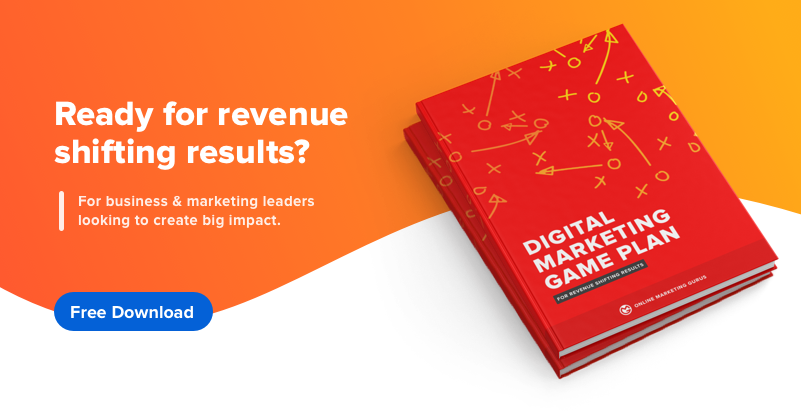How to Leverage Semantic Search in Your SEO Strategy



Do you want to understand exactly what someone is looking for on Google search, then match that with the most relevant content on your website?
Or better yet, do you wish you could take that information and use it to deliver an out-of-this-world eCommerce experience that converts more customers, time and time again?
If you’re nodding your head yes, then you NEED to get your head around semantic search.
When leveraged right in your SEO strategy, semantic search can help you bring more qualified visitors to your website from search engines, and deliver a standout experience that pays off on your bottom line.
But if you want to reap the incredible rewards of semantic search for your business, you first need to build a solid understanding of how it works and how to optimize your website accordingly.
In this post, you’ll learn:
- What semantic search is
- Why semantic search matters for SEO
- The evolution of the technology over the years
- How to optimize your SEO content and digital marketing for semantic search
- How to use semantic search to boost product discovery on your eCommerce website
What is semantic search?
Semantic search is a way for search engines to interpret the meaning behind a user’s search query, rather than relying on the verbatim text alone.
Why is this important?
Simple. When people communicate with one another, we go beyond the words that are being said. We draw upon context, cultural references, non-verbal cues, and so much more, to truly understand what is being said and the intent behind it.
We search in the same way.
Much like in a conversation, there are a MILLION ways to say the same thing in a Google search. In fact, 15% of all searches are completely new. If search engines only process the language behind searches verbatim, the results might end up being irrelevant for users or, worse yet, completely non-existent.
What’s more, the volume of conversational search queries are skyrocketing as more people start to use voice search instead of typing in Google.
Semantic search solves this problem by using search intent, query context, and the relationships between words to serve up the most relevant results possible for users.
Why does semantic search matter for SEO?
To understand why semantic search matters for SEO and content, we have to first go back to the heart of what search engines like Google want to do: deliver the most relevant and reliable information available.
Interpreting the search intent and the content behind a user’s query allows Google to deliver a more optimized experience for its users.
For example:
- If you run a search for “cafes near me”, Google knows you want to see cafes around your current location and will return local search results.
- If you search for “corona” in 2020, Google will return content related to COVID-19. If you ran the same search in 2019, you most likely would have seen results about the beer.
- If you search for “activewear for women”, you’re probably looking to shop online. Google will pull up the most relevant products via Shopping.
Search engines use two key principles to guide SEO semantic search:
1) The searcher’s intent. If a search engine understands what someone is hoping to achieve with their search, it can tailor the search results to best meet the needs of that user.
2) The semantic meaning of search terms. This gives context to the language used in a search by looking at the relationship between your search query, the words and phrases related to it, and content that’s housed in Google’s index.
Let’s say you run a search for the “the boy who lived in the cupboard under the stairs”.
Google knows you’re talking about Harry Potter based on the keywords in the search query and relationships between them, the entities behind the keywords, and the type of content searched for online.
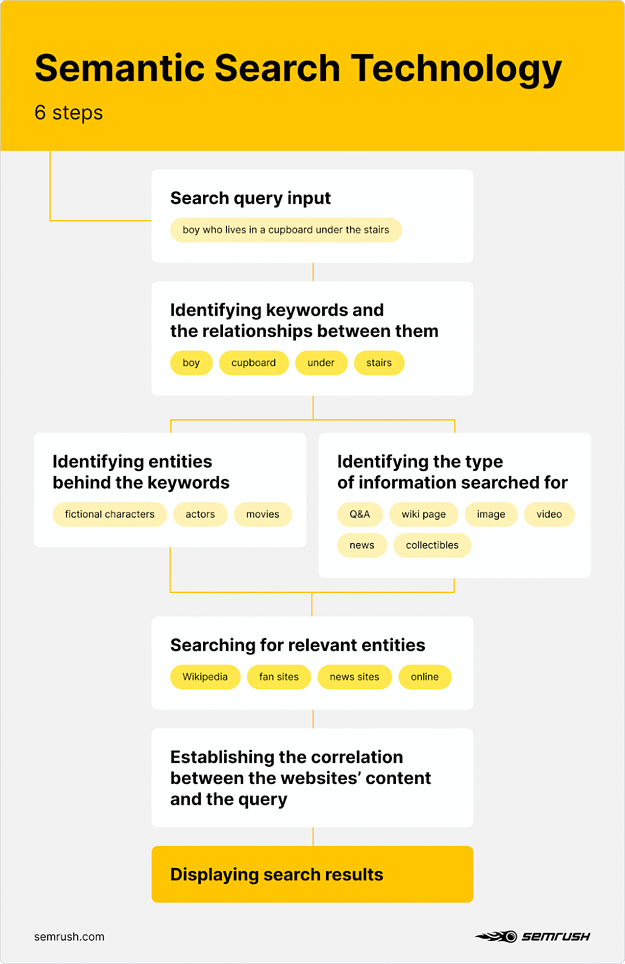
This can also help Google weed out low-quality content on the web, like spam or SEO content that’s deliberately been reverse engineered to rank for a specific keyword.
Essentially, search engines like Google are better at understanding a user’s search queries, and presenting the best search results to them, than ever before.
What does this mean for SEO?
Essentially it boils down these six changes:
- As search becomes more conversational and Google gets better at understanding the intent behind a search, brands need to start thinking about information in terms of topics, not keywords.
- High volume, high competition search keywords are less important in 2021. Instead, the focus needs to be on long-tail keywords, relevant keywords within a topic, and creating quality content.
- It’s critical to identify, understand, and analyze the intent behind a search term, then create content that’s optimized to that user’s intent.
- As Google introduces more features in search results, such as the local pack, featured snippets and Google Shopping, you need to format your content accordingly based on the feature you want to rank for.
- Structured data isn’t optional for your content — it’s a must-have.
- It’s an advantage to build up your Knowledge Graph entity and branded Knowledge Panel (we’ll cover this later).
The evolution of semantic search
Semantic search has been around a LOT longer than you might realise.
The truth is, Google has been quietly working away at semantic search since 2012. Over time, the way users search has changed — and Google has evolved and adapted its technologies along with it.
Here are the milestones you need to be across when it comes to semantic search:
1. Google’s Knowledge Graph
This is what started it all.
Google’s Knowledge Graph is the technology that enabled semantic search. It helps users discover relevant content quickly and easily, based on a MASSIVE knowledge base of entities and the relationships between them. Google itself describes its Knowledge Graph as a giant virtual encyclopedia of facts.
At the most basic level, the information in the Knowledge Graph looks like this:
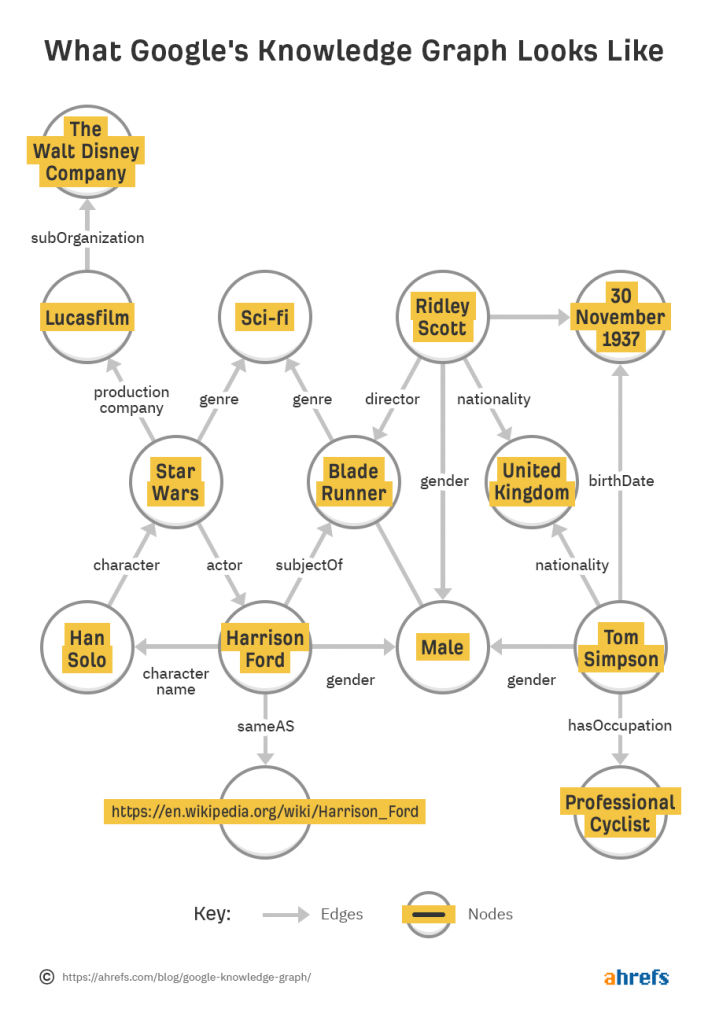
The Knowledge Graph is built upon entities, which are objects or concepts that can be identified (such as locations, people, feelings and ideas). These are linked by “edges” that describe the relationship between the two — for example, Harrison Ford’s character name is Han Solo.
These graphs also power the Knowledge Panel, which is a box that appears in Google search results with the key information about people, places and things:
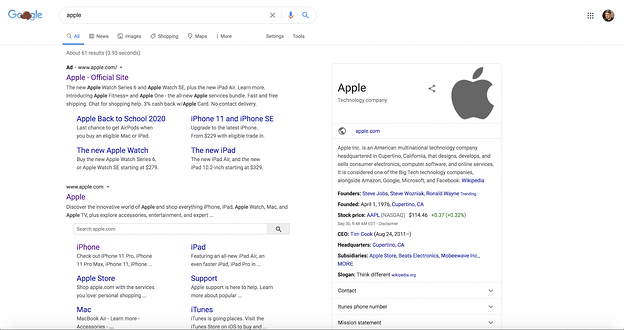
2. Hummingbird update in 2013
Google Hummingbird was the first algorithm update that switched the focus from individual keywords to natural language queries, or conversational search. This update placed emphasis on the meaning behind words, rather than the words itself.
After Hummingbird, Google started paying more attention to each word in a query and the relationship between queries — and ranking information that matched the meaning of the search query, as opposed to ranking pages that matched the keywords verbatim.
3. RankBrain update in 2016
RankBrain was the start of Google using AI to learn and analyze the meaning of words that users enter into a search engine, even if they’re unfamiliar. It better understands the meaning of words and phrases based on machine learning algorithms in order to deliver the most relevant results.
More importantly, it’s now considered one of Google’s top 3 ranking factors.
4. BERT
BERT, or Bidirectional Encoder Representations from Transformers, helps Google better understand search queries using a state-of-the-art model for natural language processing (i.e. conversational language). This was by far one of the biggest updates in SEO in 2020, with roughly 10% of all search results being affected.
BERT looks at the words that come before and after a word to better understand the context of long or complex search queries. BERT helps truly get to the heart of the intent behind a search, and deciphering any ambiguity or nuances in language.
5. Voice search
Last but not least, we have voice search. Voice search has played a huge role in the rise of semantic search, precisely because the way someone would speak their search query isn’t the same as how they would type them.
Voice searches use more natural language, consist of longer phrases, and typically include more questions than typed searches.
For example, if you’re looking for a local hardware store, you might search for “hardware store near me”. However, if you’re talking to Alexa or Siri, your language might change to “where is the closest hardware store?”
In these instances, semantic search is even more important because it helps decipher the contextual meaning behind these types of searches.
How to optimize content for semantic search
It’s all well and good to understand what semantic search is, and how it works.
But how can you use this information in your digital strategy to drive more qualified traffic and bring home more sales?
1. Optimise your SEO content for topics instead of keywords
Here’s the deal: keywords aren’t dead. Semantic search has just cast the wide net open, forcing businesses to think more broadly in terms of topics than focus on targeting one term at a time.
See, Google’s search algorithm is MUCH more sophisticated thanks to semantic search. It understands that there are multiple ways to search for the same thing, and all of these searches should return the same results.
Here’s an example: Let’s say one person runs a search for “buy homewares online” and another runs a search for “online homewares store”.
In both instances, the user is clearly intending to find information about an eCommerce store that sells homewares. Historically, search engines might have ranked one group of websites on page one for “buy homewares online” and another completely different group for “online homewares store”.
With semantic search, Google understands that both queries mean the same thing, and the search results for both queries should pretty much be the same.
So what does this mean?
The goal isn’t to rank for one keyword anymore. It’s to create content that ranks for long-tail keywords and related keywords.
Rather than targeting one keyword at a time with multiple pages filled with shallow content, businesses should be working to create one piece of quality content that covers a topic in greater depth and includes a range of keywords that are related to that topic.
Let’s look at that homewares example again.
In the old days, you might have created a piece of content that targeted “buy homewares online”, another that targeted “online homewares store”, and another for every different product range. However, Google knows that someone looking for homewares is probably looking to buy tables, chairs, glassware, vases, and other products. If you want to optimize your content for semantic search, you should be including as many of these keywords as possible on the same page.
One word of advice: don’t go too far in the other direction and write thesis-length content for every topic that’s related to your business. Take time to better understand how your keywords fit together, which ones are most relevant to your topic, and what the search intent is behind different keywords.
2. Get to the heart of user intent
There’s an intention behind every single search, which is why user intent is such a MASSIVE part of semantic search.
If you can get better at understanding what your audience is trying to achieve when they search for a specific phrase, you can create content to give them the best user experience possible once they’re on your website — and shoot up to the top of search as a result.
So what is user intent?
Google summed it up perfectly in this chart showing micro-moments:
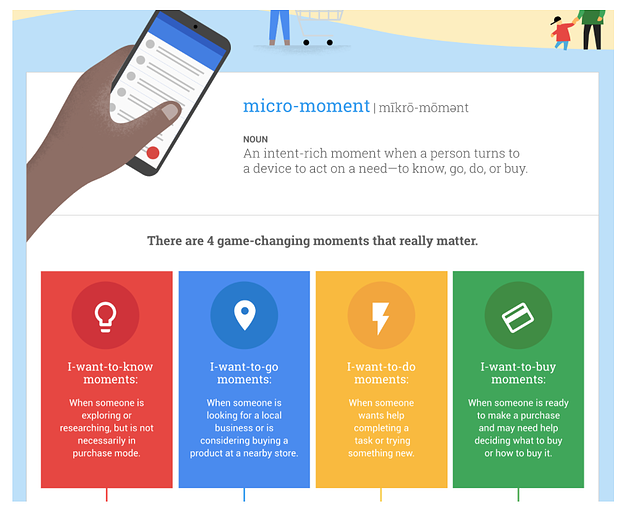
These ‘micro-moments’ are the backbone of search intent.
Before you start developing any type of content, you need to understand where a user sits in the journey. Map your target keywords and topics against their search intent, then reverse engineer your SEO strategy to give them the high-quality content to meet their needs.
Here’s an example of how we do it at OMG:
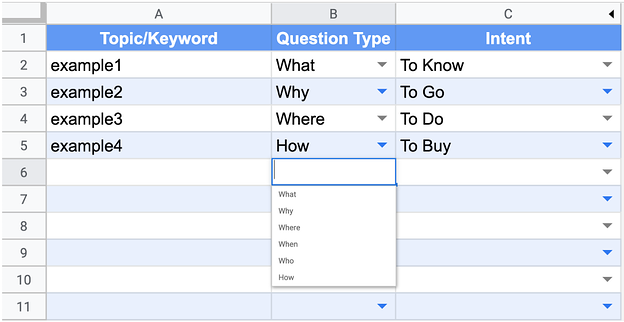
Another tip? Run a Google search for the keywords you’re trying to cover BEFORE you begin developing your content.
If you search for “wool blankets” and see product pages, that’s a surefire sign that Google thinks the main intent behind the search query is transactional. On the other hand, if you search for “best types of blankets” and see that the top-ranking pages are content articles with information on the different types of materials for blankets, it’s a signal that Google sees the search intent as commercial.
3. Incorporate semantic HTML
Stay with us here.
You’ve probably heard of HTML — after all, it’s how all content on the internet is coded. However, HTML language on its own has no explicit meaning. It’s just a series of code that doesn’t indicate any of the contents within the code.
Semantic HTML adds a layer of contextual meaning to the code that helps machines recognize and understand different parts of the page, such as headers, blocks, navigation, and videos.
This chart by Ahrefs shows how code looks with and without semantic HTML:
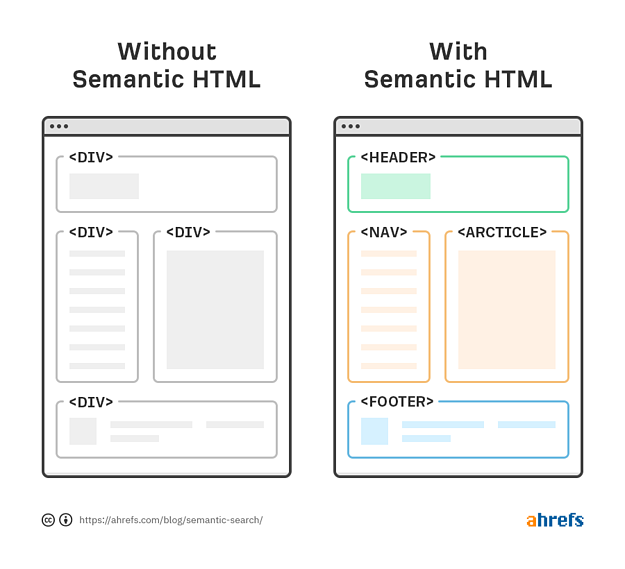
If your website code doesn’t already include semantic HTML, it’s time to make the switch. Talk to your development team or your technical SEO agency to work out the best option. It might be a matter of simply adding in a plugin to add this layer of semantic HTML to your existing page.
4. Get into Google’s Knowledge Graph
The Knowledge Graph lies at the heart of all semantic search. If you can get your business to become a Knowledge Graph entity, you’ll earn yourself a coveted spot (and a TON of extra visibility) in Google’s Knowledge Panels or Knowledge Cards.
There is no clear-cut process to get into Google’s knowledge graph, but there are a few things you can do to improve your chances:
- Focus on your PR and link building efforts to build credibility and buzz online.
- Use structured data on your website (more on this soon).
- Create a Google My Business profile. Make sure to keep all of your details consistent across your website, GMB listing, social media pages, and directory links.
- Get featured as a source in Wikipedia, or by creating an entry on wikidata.org.
- Claim and suggest changes to your branded Knowledge Panel, if you have one.
5. Get your content to appear as a featured snippet
The featured snippet is one of THE most sought after positions on search. They appear in position ‘zero’ above all the other pages, and are a sign from Google that your web page is the most direct and helpful piece of content on the entire web.
It’s also almost entirely based on semantic search.
Getting your content to rank for a featured snippet is an entire strategy in and of itself. If you’re aiming to earn that position zero spot, take a look at our ultimate guide to featured snippets for tangible strategies and insights.
6. Use structured data (AKA schema markup)
Schema markup is a semantic framework that’s used to mark up content around the web. By including structured data in your code, you make it easier for search engines to grab key pieces of information in your content without needing to use complex algorithms.
There are literally hundreds of types of schema vocabulary, ranging from the length of cooking time for a recipe to the color of a specific product. And while schema markup is helpful for all websites, it’s an absolute MUST for eCommerce brands.
Why?
Schema markup provides additional context around your products or services which, in turn, helps search engines rank content.
Let’s say you sell dresses, and a user runs a search for “blue dresses XS”. If you mark up your content with the color and size using structured data, it helps Google recognize that you offer the product that this user is searching for.
So how can you use schema markup?
Follow these three steps:
- Go to schema.org and have a look at the schema types that are offered by your target search engines.
- Use a markup generator to mark up your content, such as Google’s Structured Data Markup Helper or the Schema Markup Generator by Merkle.
- Check that your markup was implemented correctly using Google’s Rich Results Test.
7. Build up relevant, high-quality backlinks
Semantic search has affected a lot of different aspects of SEO, but this method is still as important now as it was ten years ago.
Links are one of the main ways that search engines judge relevancy and context for content around the web. Regardless of whether a link is internal or external, linking between different web pages is a sign that those two sites are connected in some way.
A solid eCommerce link building strategy helps a search engine understand your content better, connects the dots between your website and relevant industries, and show that your website is an authority in your field. More importantly, it helps strengthen your chances of getting into Google’s Knowledge Graph.
If you want to rake up the backlinks and skyrocket your rankings, try these 10 tried-and-tested strategies for eCommerce brands.
eCommerce Bonus Tips: Boosting product discovery with semantic search
Beyond Google search, there are some specific actions you can take to improve product discovery on your website using semantic search.
Why does this matter?
Because searching is a critical part of the eCommerce customer journey.
Here’s a flow chart that illustrates how users behave when they get a relevant result, compared to an irrelevant result on your website:
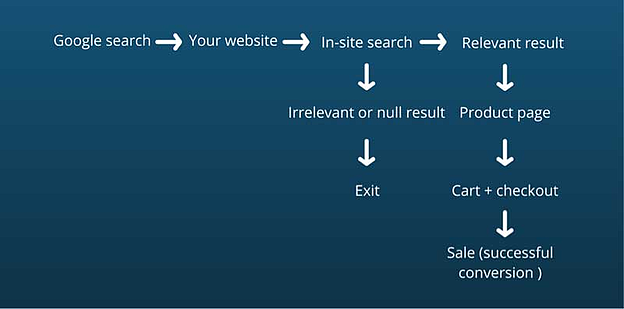
Having an effective website search is critical to securing more successful conversions. If your users can’t find what they want, they’ll get frustrated, abandon their cart, and go straight to your competitors.
Semantic search can improve the product discovery process for users, helping them to find the right products more quickly. When you deliver a stellar user experience, that reflects in your rankings on search engines— and in your revenue.
1. Use clickstream data to improve search results for users
Let’s say you’re running The Iconic, and you have thousands of products in your store. A customer might search for “dresses”, but how do you choose which dresses to show on the first page?
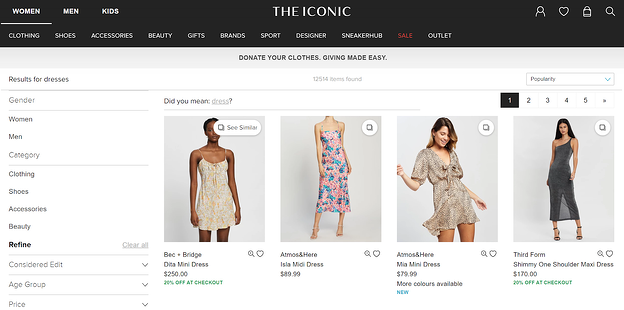
The popular approach is to use metrics like sales and product rating to produce a ranking score for the product. However, there are a TON of different types of dresses: maxi dresses, party dresses, midi dresses, bodycon dresses — and the list goes on.
If you’re only sorting based on sales or product rating, your users might end up getting a kid’s dress in their search result, even if they were looking for a dress for an adult.
How can you address this?
Simple: clickstream data.
Clickstream data is the pathway that a user takes through their online journey from discovery to conversion. By mining clickstream data, you can train your search engine to use machine learning to predict the most commonly clicked product types for those customers and show the most relevant result.
2. Recognise product categories and suggest similar products
If your customers are looking for a brand that you don’t carry, you either have two choices:
- Send them off on their way, straight to your competitors
- Recommend similar products based on the category they’re searching for
If your goal is conversions and revenue, number 2 is the way to go. So how do you do this?
The aim here is to have your search engine recognize the intent behind the search request, and suggest a suitable alternative.
To illustrate this, let’s take a look a search for “The Office” on Netflix:

Although Netflix doesn’t have The Office, the search engine recognizes the user’s interest in sitcoms and presents relevant shows, like The IT Crowd, Brooklyn Nine-Nine, and The Good Place.
You can do the same thing with your product search.
If your users are searching for a brand you don’t stock, suggest an alternative brand that offers similar products. For example, if someone searches for Pandora charms, you can set up your search engine to recommend other charm bracelets instead:

You can also set your search engine to recognize the category of search and recommend similar products.
Let’s say someone is searching for a copy of Lord of the Rings. If you don’t have it in stock, the goal is to have your search engine recognize the genre (fantasy) and suggest similar products in that category.
3. Accommodate misspellings and typos
It’s no secret that users research online before buying a product. But sometimes, a small thing like a typo can mean you lose out on thousands of potential customers.
Let’s use an example from Amazon. Someone runs a misspelled search for “childrn’s book age 1 to 5”, only to find this:
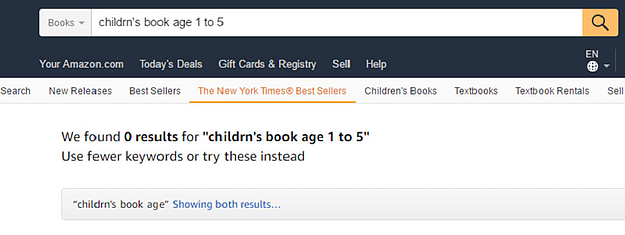
This is clearly a typo, but it results in a user receiving 0 results for the search query. If someone’s in a hurry or not paying attention to the page, they might think that Amazon has no books for kids between 1 to 5 years old.
This single spelling mistake would cost Amazon real customers and real revenue.
Here’s the thing. You can’t control WHAT users are going to search for. But you CAN ensure that your eCommerce search function is intelligent enough to understand when a user has made a typo, and suggest the right product to match.
There are two ways you can do this on your website. The first is to suggest a spelling correction with a “Did you mean…” message, like so:
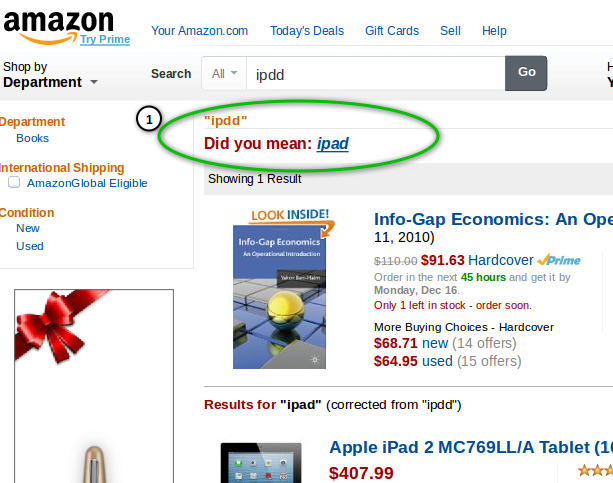
Another option is to add popular search terms as top suggestions or using intelligent autocomplete, based on the results your previous users found most useful:
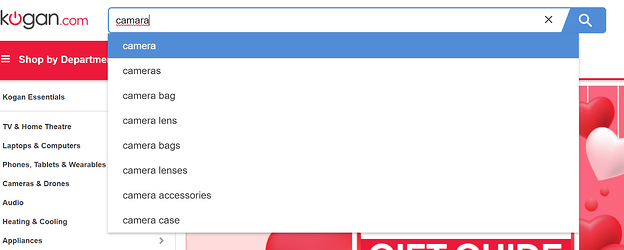
Supercharge your search ranking with semantic SEO
Here’s the bottom line: Semantic search is the future of SEO. If you want to get to the top of search and stay there, you need to jump on the bandwagon NOW.
But the truth is, for most eCommerce businesses, this is easier said than done.
Semantic search is harder than old school SEO, because it requires an understanding of technical SEO, such as structured data and semantic HTML, as well as user-centric concepts, such as search intent, content topics and the customer journey.
It’s an art AND a science, and it takes a team of SEO specialists to get you the results you’re looking for: the ones that make an impact on your bottom line.
If you want to get ahead of the game, you need to have the best on your side. Claim your digital marketing audit today, and we’ll show you how to achieve better rankings and more revenue with semantic search — all for FREE.


